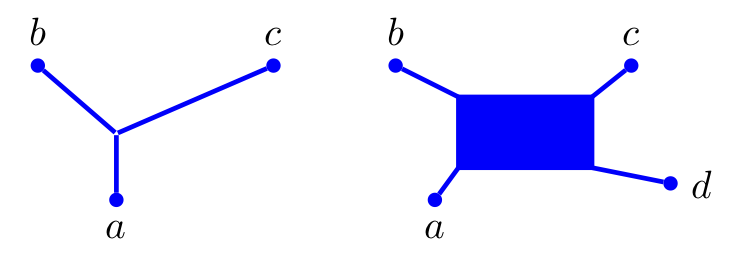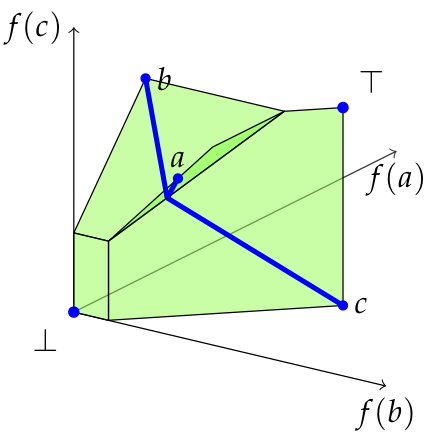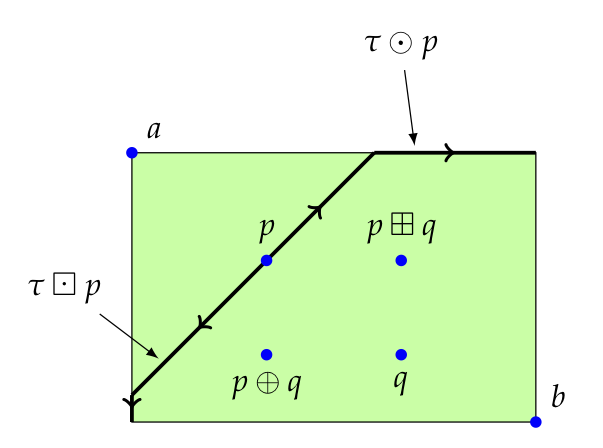Tight Spans, Isbell Completions and Semi-Tropical Modules
Posted by Simon Willerton
Some time ago, in a response to a comment on a post (?!) I said that I wanted to understand if the tight span construction for metric spaces could be thought of in enriched category theory terms. Tom suggested that it might have something to do with what he calls the Isbell completion construction. Elsewhere, in a response to a post on Equipments I was wondering about connections between metric spaces as enriched categories and tropical mathematics. I have finally got round to writing up a paper on these things. The draft can be found in the following place.
The paper was written to be accessible to people (such as metric geometers or tropical algebraists) with essentially no background in category theory, but to show how categorical methods apply. Consequently, parts of the paper on cocompletion might be seen as a bit pedestrian by some of the categorical cognoscenti. I would be interested to hear thoughts that people have. I will give an overview below the fold.
Generalized metric spaces
Recall that there is a notion due to Lawvere of a generalized metric space. The essential difference from the notion of classical metric spaces is that for a generalized metric space we don’t impose symmetry, so that in general ; however, we do impose the triangle inequality and zero self-distance . A generalized metric space is actually defined to be a category enriched over the extended non-negative real numbers , and this idea creates a bridge between enriched category theory and metric space theory.
Tight span
For classical metric spaces the idea of tight span has cropped up in many places independently over the years and has many applications, it was first discovered by Isbell in 1964. For a classical metric space the tight span can be thought of as a minimal contractible classical metric space in which embeds isometrically.
For generic three- and four-point metric spaces here are pictures of the tight spans.

One reason that the tight span is of interest is that embeds in a tree if and only if the tight span is a tree, this underlies some of the applications to phylogenetic analysis, i.e. recreating evolutionary trees of species from genetic data. There are also applications to multicommodity flows on networks, server positioning and group cohomology.
Isbell completion
The Isbell completion for an generalized metric space is a certain generalized metric space in which embeds isometrically. There are appropriate notions of categorical completeness and cocompleteness of a metric space (see below for ways of thinking of these) which are not to be confused with the usual notion of metric space completeness. The Isbell completion is complete and cocomplete, moreover the embedding is continuous and cocontinuous.
The Isbell completion is defined is defined in terms of “presheaves” and “copresheaves” on the space . Presheaves and copresheaves are certain kinds of functions , for example, for a fixed point the function is a presheaf and the function is a copresheaf. Each point in the Isbell completion is a pair where is a presheaf and is a copresheaf, with the interpretation that for any you have is the distance to from and is the distance from to .
For example, the Isbell completion of a generalized metric space with two points is a rectangle (pictured further down this post), the Isbell completion of a classical metric space with three points can be pictured as the union of four polygons in three-space like so.

The metric here is an asymmetric version of the -metric on , so .
In categorical language, the Isbell completion of a generalized metric space is defined to be the “invariant part” of the “Isbell adjunction” between the space of presheaves and space of op-co-presheaves:
with and similarly for . So a point is the Isbell completion is a pair with and .
Tight span and Isbell completion
The connection between the tight span and the Isbell completion is that for a classical metric space the tight span is the maximal classical space containing inside the Isbell completion . For example it is drawn in blue in the above picture of the Isbell completion of a three-point classical metric space. This means that the Isbell completion can be thought of as generalized metric space analogue of the tight span.
Directed tight span
After having figured all of this out I discovered that a couple of Japanese mathematicians, Hirai and Koichi, had defined an analogue of the tight span for what they called “directed metric spaces” which are not quite as general as generalized metric spaces but are the same in that they don’t impose the symmetry of the metric.
H. Hirai and S. Koichi, On tight spans and tropical polytopes for directed distances
They were motivated by applications to multicommodity flow on directed networks. It transpires that their directed tight span is basically the Isbell completion.
Semi-tropical algebra
Tropical mathematics is a broad an active area of mathematics being studied for many reasons, but has at its heart the so-called tropical semi-ring . (Here the term “semi-ring” means a ring without additive inverses, such a thing is also called a “rig”.) Actually there are a few minor variants of “the” tropical semi-ring but we can take to be the extended real numbers with “min” as the addition – written – and “usual ” as the multiplication – written . Then is the additive unit and is the multiplicative unit. For example,
The tropical semi-ring is actually a semi-field as all of the non- elements have multiplicative inverses, e.g. . We are not interested at this point in the negative reals and will consider the semi-ring . As this is half of the tropical semi-ring I have named it the semi-tropical semi-ring, and we can denote it .
Modules over the tropical semi-ring are of much interest; a module over a semi-ring is a commutative monoid with an action , in the usual sense, of the semi-ring on it. As the tropical semi-ring is a semi-field, modules over it are free, in particular a module over comes with a flow, i.e. an action of the extended reals on it.
Develin and Sturmfels thought that they were able to show that the classical tight span was a tropical module (modulo the flow), but found an error in their proof. This is the use of the word tropical in Hirai and Koichi’s paper above.
Modules over the semi-tropical semi-ring are a bit more mysterious at this point, but in particular they only have a semi-flow, so points can be moved forward in time, if you will, but cannot be moved backwards in time.
Completeness, cocompleteness and semi-tropical modules
We can now go back to completeness and cocompleteness of generalized metric spaces. It transpires that a generalized metric space is cocomplete if and only if it can be given a semi-tropical module structure in a way compatible with the metric. (I should be careful and say that the generalized metric space has to be skeletal there.) Similarly being complete corresponds to being a semi-tropical module in a way differently compatible with the metric. The point here is that generalized metric spaces are enriched over and it is this that naturally acts.
As the Isbell completion is both complete and cocomplete, it can be given two different semi-tropical modules structures. In the very simple case of an asymmetric generalized metric space with two points, the two semi-tropical module structures and are pictured as follows, where .

The semi-tropical action on the Isbell completion of three points pictured further up is going to be more complicated.
Anyway, to sum up, from the categorical point of view, gives you various structures that are of interest. In particular, we get these semi-tropical structures naturally occurring on Hirai and Koichi’s tight span which they had not looked at. It seems people were looking for tropical actions.
Postscript: Formal concept analysis
In the last week Dusko Pavlovic pointed me to his paper
In this paper he also defines what I’ve termed the Isbell completion for what are essentially generalized metric spaces (but he uses the equivalent context of “proxets”). His motivation and notation are rather different however. He goes on to define a generalization of the Isbell completion for any profunctor between generalized metric spaces, he calls this generalized metric space the “nucleus” of and it consists of pairs where is a presheaf on and is a copresheaf on . I have some ideas about this, but haven’t thought too much about it yet.

Re: Tight spans, Isbell completions and semi-tropical modules
I don’t quite understand the details, but this looks quite neat! Is the Isbell who first defined the tight span the same Isbell that the Isbell completion is named after? Was he aware of a relationship between the two? I see that the tight span was defined a decade or so before Lawvere wrote about metric spaces as enriched categories; when was the Isbell completion first defined?